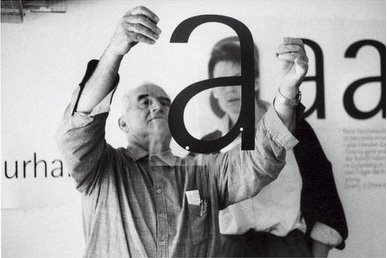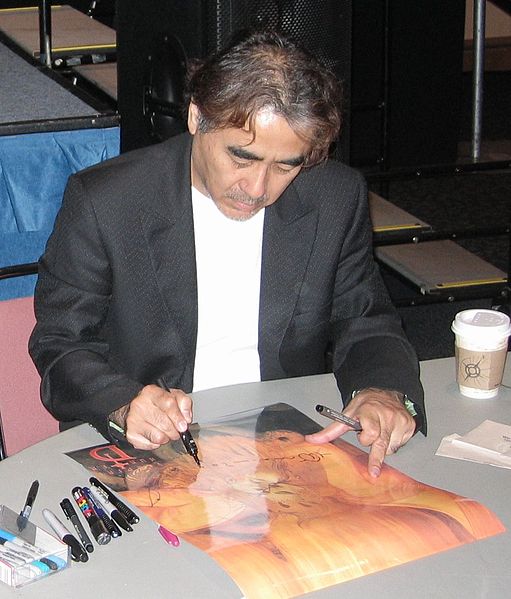<Back to Index>
- Graphic Designer Otl Aicher, 1922
- Designer and Illustrator Yoshitaka Amano, 1952
PAGE SPONSOR

Otl Aicher (May 13, 1922 – September 1, 1991), also known as Otto Aicher, was a German graphic designer.
Born in Ulm, Aicher was a classmate and friend of Werner Scholl, and through him met Werner's family, including his siblings Hans and Sophie Scholl, both of whom would be executed in 1943 for their membership in the White Rose resistance movement in Nazi Germany. Like the Scholls, Aicher was strongly opposed to the Nazi movement. He was arrested in 1937 for refusing to join the Hitler Youth, and consequently he was failed on his abitur (college entrance) examination in 1941. He was subsequently drafted into the German army to fight in World War II, though he tried to leave at various times. In 1945 he deserted the army, and went into hiding at the Scholls' house in Wutach.
In 1946, after the end of the war, Aicher began studying sculpture at the Academy of Fine Arts Munich. In 1947, he opened his own studio in Ulm.
In 1952 he married Inge Scholl, the older sister of Werner, Hans and Sophie.
In 1953, along with Inge Scholl and Max Bill, he founded the Ulm School of Design (Hochschule für Gestaltung Ulm), which became one of Germany's leading educational centers for design during the 1950s and 1960s. Faculty and students include such notable designers as Tomás Maldonado, Max Bill, and Peter Seitz.
He was heavily involved in corporate branding and designed the logo for German airline Lufthansa in 1969.
Aicher may be best known for being the lead designer for the 1972 Munich Olympics. He created a new set of pictograms that paved the way for the ubiquitous stick figures currently used in public signs. The pictograms were created to provide a visual interpretation of the sport they featured so that athletes and visitors to the Olympic village and stadium could find their way around. He created pictograms using a series of grid systems and a specific bright color palette that he chose for these Games. In 1966 Aicher was asked by the organizers of the Games to create a design for the Olympics that complemented the architecture of the newly built stadium in Munich designed by Günther Behnisch. Aicher consulted Masaru Katsumie who designed the previous 1964 Tokyo Olympic Games, for advice on how to create the new designs for the 1972 Munich Olympic Games.
Otl Aicher also helped to design the logo of the Munich Olympics. He went through several stages with his design team before finally finding the successful emblem. One of their first ideas was to use an element of the city's coat of arms or Münchner Kindl within the design which showed a monk or child pointing into the distance while clasping a book in his hand. Other ideas were to use the surrounding areas of the city, referencing the sun, mountains and landscape within the design. Finally the Strahlenkranz was created, a garland which represented the sun but also the five Olympic rings merged together in a spiral shape. Designer Coordt Von Mannstein reworked Aichers original design through a mathematical calculation to amalgamate the garland and spiral together to get the final design.
The colors chosen for the designs of the games were selected to reflect the tones of the Alps. The mountains in blue and white would make up the palette of colors which also included green, orange and silver. The colors were used to identify allocated themes such as media, technical services, celebrity hospitality and public functions and each had a different color so visitors could differentiate the themes around the stadium and village. Uniforms were color coordinated to represent these themes, the Olympic staff could be identified as working for a particular department by the color they were wearing.
Aicher used the typeface Univers for the Olympic designs. The design team produced 21 sports posters to advertise the sports at the games, using the official design colors and also including the logo and "München 1972". The design team used a technique called "posterization" for the graphics on the posters, separating the tonal qualities from the images and using the official Munich colors for these games. This had to be produced manually as photoshop did not exist at this time. The first of these posters that was created manually in this way was a poster of the Olympic stadium which became the official poster for these games. These posters were displayed all around the city of Munich and around the Olympic sites. Posters were hung in twos alongside posters designed by famous artists chosen to represent this Olympics such as David Hockney, R.B. Kitaj, Tom Wesselmann and Allan Jones.
He also created the first official Olympic Mascot, a striped dachshund named Waldi.
In 1980 Otl Aicher became a consultant of the kitchen company bulthaup. He created the rotis font family in 1988, naming it after the domicile of Rotis in the city of Leutkirch im Allgäu, where Aicher lived and kept his studio which is still used today by bulthaup.
He has also designed the logo of Munich Airport, consisting of the letter M in a simple sans serif font.
Aicher died in Günzburg on September 1, 1991, after being struck in a traffic accident.

Yoshitaka Amano (天野 喜孝 (formerly 天野 嘉孝) Amano Yoshitaka, born July 28, 1952) is a Japanese artist. He began his career as an animator and has become known for his illustrations for the anime Vampire Hunter D and for his character designs, image illustrations and title logo designs for the Final Fantasy video game series developed by Square Enix (formerly Square). His influences include Western comic books, art nouveau, and Japanese woodblock prints. He has won awards for his work, including the 1999 Bram Stoker Award for his collaboration with Neil Gaiman, Sandman: The Dream Hunters. In early 2010, he established Studio Devaloka, a film production company.
Amano was born in Shizuoka, Japan. As a young adolescent, he was fascinated with drawing. In 1967, he began working in the animation department of Tatsunoko Productions, where he was introduced to the early Japanese anime movement. His first paid project was for the Speed Racer anime franchise. He was a character designer for anime shows such as Time Bokan, Gatchaman, Tekkaman, and Honeybee Hutch.
In the 1960s, Amano was exposed to Western art styles through comic books, which he claims among his artistic roots. He has cited Neal Adams as his favorite comic book artist, noting that he would often purchase used comics based on Adams's cover artwork, only to be disappointed that the interior artist was different. Amano was also fascinated by the art styles of psychedelic art and pop art of the West, particularly the work of American Pop artist Peter Max. In the 1970s, Amano studied the artworks of the late 19th century and early 20th century European movement of Art Nouveau, as well as the ancient Japanese hand woodblock printing work of Ukiyo-e.
Amano remained at Tatsunoko Productions until 1982.
In the early 1980s, Amano concentrated on illustrations for science fiction and fantasy works. Combined with the influence of his prior experience in animation, this focus resulted in a personal style influenced by both modern surrealism and realism.
In 1983, he illustrated the novel Demon City Shinjuku and the first in Hideyuki Kikuchi's Vampire Hunter D novel series. He also worked as a character designer on the 1985 movie adaptation of Vampire Hunter D, which was one of the first anime movies to be released outside of Japan. In interviews, however, Amano has stated that he was not pleased with the final product of the movie.
His illustrations began to be published in collections such as Maten in 1984.
In 1987, Amano joined Square (now known as Square Enix) to work on a role playing video game for the Nintendo Entertainment System: Final Fantasy. Amano produced conceptual design pieces for the game in both traditional and computer designed artwork. At this time, he also worked for another video game company, Kure Software Koubou, producing box cover illustrations as well as some character designs. This work included designs for Kure's First Queen series.
Following Final Fantasy VI in 1994, he stepped down as the main character, image, and graphic designer of the series. He continued to provide promotional and character artwork for subsequent games and to design their title logos.
In 2006, Hironobu Sakaguchi, the former designer and creator of the Final Fantasy series, recruited Amano and composer Nobuo Uematsu to work on video games at Mistwalker.
Amano's first exhibition, called "Hiten", was held in 1989 at Yurakucho Mullion in Tokyo, Japan. In 1990, he began to work as an artist and set designer for stage theater. His first work for theater was Tamasaburo Bando's Nayotake. He also held further exhibitions and became well known for his printing works.
Beginning in 1995 with his work at the Biennale d'Orléans in France, he received increased recognition outside of Japan. Further international exhibitions followed, including the 1996 "Hero" at the Angel Orensanz Foundation and the 1997 workshop and exhibition "Think Like Amano".
In 1998, Amano appeared as Hiroshi in the 1998 movie New Rose Hotel, loosely based on the William Gibson short story of the same name.
In 2000, Amano illustrated Neil Gaiman's Sandman: The Dream Hunters, which won several awards and was nominated for a Hugo Award. In 2001, Greg Rucka and Amano collaborated on another comic book tale, Elektra and Wolverine: The Redeemer. His character designs were used in another Vampire Hunter D movie entitled Vampire Hunter D: Bloodlust. In 2006, the first volume of his HERO series was released by Boom! Studios.
He illustrated three album covers for the Japanese power metal band Galneryus: The Flag of Punishment (2003), Advance to the Fall (2005), and Beyond the End of Despair (2006).
In 2008, Amano created an illustrated adaptation of Wolfgang Amadeus Mozart's The Magic Flute, published by Radical Comics. He also collaborated with Christopher "mink" Morrison of Quentin Tarantino's A Band Apart production company, providing illustrations for the novel Shinjuku and two other projects that have yet to be announced. He was the character designer for the 2009 Jungle Emperor (Kimba the White Lion) TV special, directed by Gorō Taniguchi, to commemorate both the 50th anniversary of Fuji Television and the 80th anniversary of Osamu Tezuka's birth.
In 2010, following a small solo art exhibition tour titled "Devaloka" it was announced that Amano had established a film production company, Studio Devaloka, and would be directing a 3D anime titled Zan, with additional projects to be announced in the future. On December 15, 2010, the official website for the film, now titled Deva Zan, was unveiled, along with information concerning an upcoming press conference, to be held on December 21, 2010. The roughly ten minute long conference revealed details about the project, including staff, as well as a short trailer for the film, which stylistically emulates the look of Amano's paintings.